display Alfa Romeo 156 2006 Owner handbook (in English)
[x] Cancel search | Manufacturer: ALFA ROMEO, Model Year: 2006, Model line: 156, Model: Alfa Romeo 156 2006Pages: 357, PDF Size: 5.04 MB
Page 124 of 357
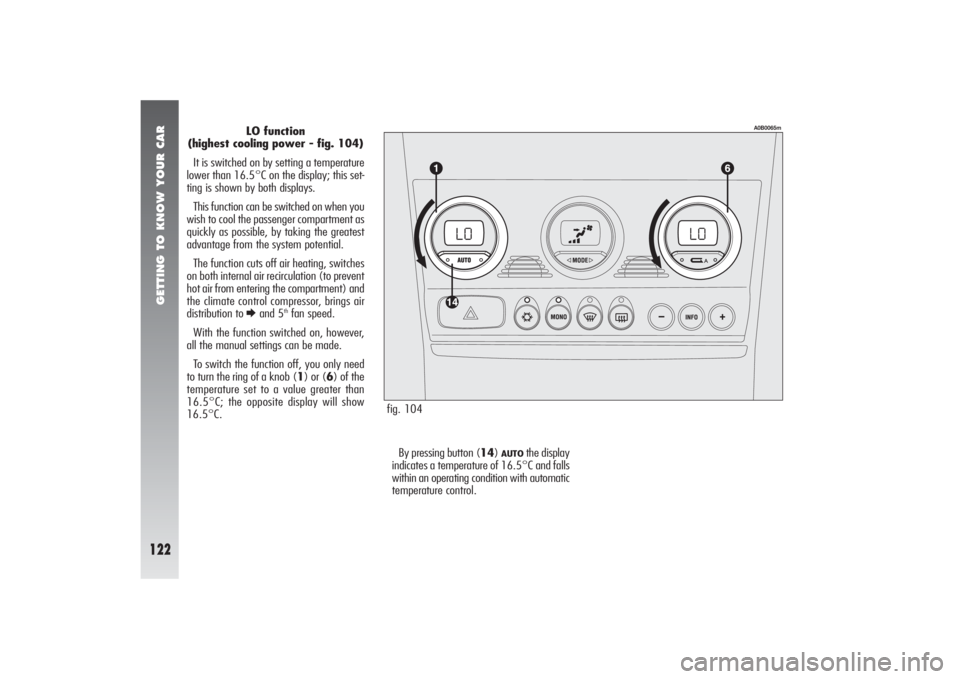
GETTING TO KNOW YOUR CAR
122
LO function
(highest cooling power - fig. 104)
It is switched on by setting a temperature
lower than 16.5°C on the display; this set-
ting is shown by both displays.
This function can be switched on when you
wish to cool the passenger compartment as
quickly as possible, by taking the greatest
advantage from the system potential.
The function cuts off air heating, switches
on both internal air recirculation (to prevent
hot air from entering the compartment) and
the climate control compressor, brings air
distribution to E
and 5
thfan speed.
With the function switched on, however,
all the manual settings can be made.
To switch the function off, you only need
to turn the ring of a knob (1) or (6) of the
temperature set to a value greater than
16.5°C; the opposite display will show
16.5°C.
fig. 104
A0B0065m
By pressing button (14)
AUTO
the display
indicates a temperature of 16.5°C and falls
within an operating condition with automatic
temperature control.
Page 126 of 357

GETTING TO KNOW YOUR CAR
124
FAN SPEED ADJUSTMENT
KNOB
(fig. 106-107)
Turning the ring of knob (3), clockwise
or counterclockwise will cause the fan speed
- and, therefore, the amount of air flowing
into the passenger compartment - to in-
crease or decrease, respectively; the 16
speeds that can be selected are displayed
by a bar (every 3 clicks), up to a maximum
of 6 illuminated bars:
– max. fan speed = all bars lit;
– min. fan speed = one bar lit.
The fan can be cut off (all bars off) only
if the climate control compressor has been
switched off by pressing button (12)
√
.
To resume automatic fan speed control af-
ter a manual setting has been made, press
button (14)
AUTO
. By fully turning the ring
of knob (3) counterclockwise, the system
will be turned off, with the following situa-
tion: display (2) OFF; display (5) OFF; cen-
tral display (4) OFF and left-hand led avail-
able on internal air recirculation button (7)
v
ON and both led on AUTO button
switch OFF.WARNINGBy pressing the internal air
recirculation button (7)
v
, it is possible
to let external fresh air into the passenger
compartment.
fig. 106
A0B0067m
Page 130 of 357

GETTING TO KNOW YOUR CAR
128
When the climate control compressor is off,
it is not possible to admit air to the pas-
senger compartment with a temperature be-
low the outside temperature; in this case,
the value flashes on the display concerning
the temperature that cannot be reached
and the left led on button (14
AUTO
-
fig. 110) goes off.
The switching off of the climate control
compressor remains in storage even when
the engine has been stopped. To resume au-
tomatic control for switching on the climate
control compressor, press button (12) √
again, the button led will turn on, or press
button (14)
AUTO
; in which case, the other
manual settings set will be cancelled.
fig. 110
A0B0071m
Operation of the climate
control compressor is nec-
essary for cooling and dehumidify-
ing the air; it is advisable to keep
this function always on, to prevent
window misting problems.
WARNING
Page 134 of 357
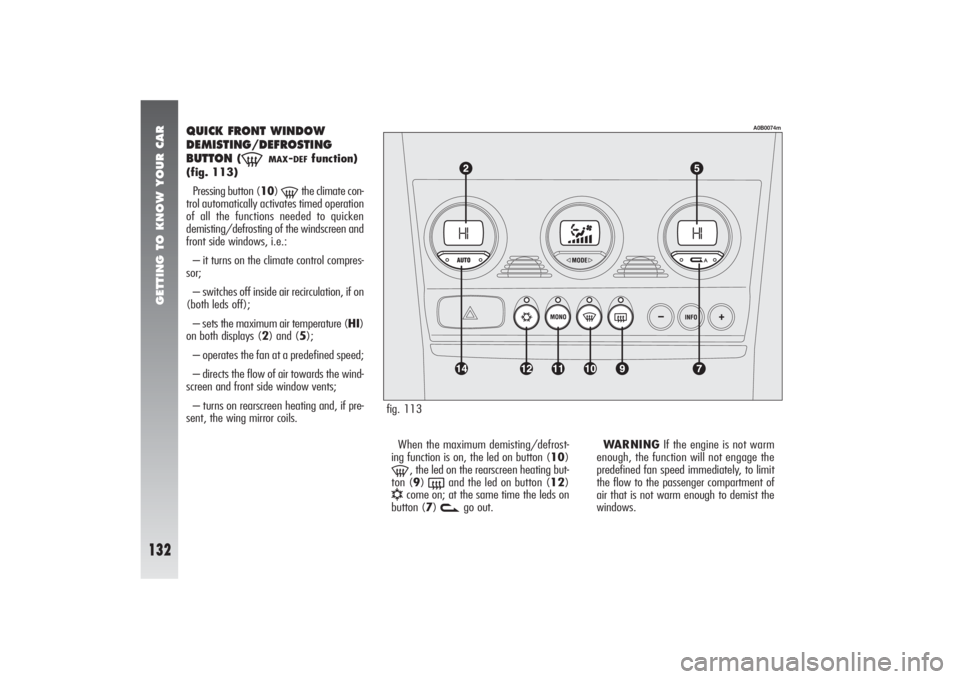
GETTING TO KNOW YOUR CAR
132
fig. 113
A0B0074m
QUICK FRONT WINDOW
DEMISTING/DEFROSTING
BUTTON
(-
MAX
-DEF
function)
(fig. 113)
Pressing button (10)
-
the climate con-
trol automatically activates timed operation
of all the functions needed to quicken
demisting/defrosting of the windscreen and
front side windows, i.e.:
– it turns on the climate control compres-
sor;
– switches off inside air recirculation, if on
(both leds off);
– sets the maximum air temperature (HI)
on both displays (2) and (5);
– operates the fan at a predefined speed;
– directs the flow of air towards the wind-
screen and front side window vents;
– turns on rearscreen heating and, if pre-
sent, the wing mirror coils.
When the maximum demisting/defrost-
ing function is on, the led on button (10)
-
, the led on the rearscreen heating but-
ton (9)
(
and the led on button (12)
√
come on; at the same time the leds on
button (7)
v
go out.WARNINGIf the engine is not warm
enough, the function will not engage the
predefined fan speed immediately, to limit
the flow to the passenger compartment of
air that is not warm enough to demist the
windows.
Page 139 of 357

GETTING TO KNOW YOUR CAR
137
Inspect the care carefully to make sure that
there are no fuel leaks, for instance in the
engine compartment, under the vehicle or
near the tank area.
If no leaks are found and the vehicle can
be restarted again, press button (A) to ac-
tivate the fuel supply system.
After a collision, remember to turn the ig-
nition key to STOP so as not to run the bat-
tery down.
INERTIAL FUEL CUT-OFF
SWITCH
(fig. 119)
This is an automatic safety switch which is
triggered in the event of crash to interrupt
the flow of fuel.
The intervention of the inertial switch is in-
dicated by a message + symbol on the In-
focenter display (see “Infocenter Display”
in this chapter) and by the door unlocking.
fig. 119
A0B0574m
fig. 120
A0B0044m
OPENING THE FUEL FLAP(fig. 120)
The fuel flap is released from inside the car
raising the front part of the lever (A).
If a smell of fuel is noted
following an accident, or
the fuel system is leaking, to avoid
the risk of fire do not reset the
switch.
WARNING
Page 144 of 357
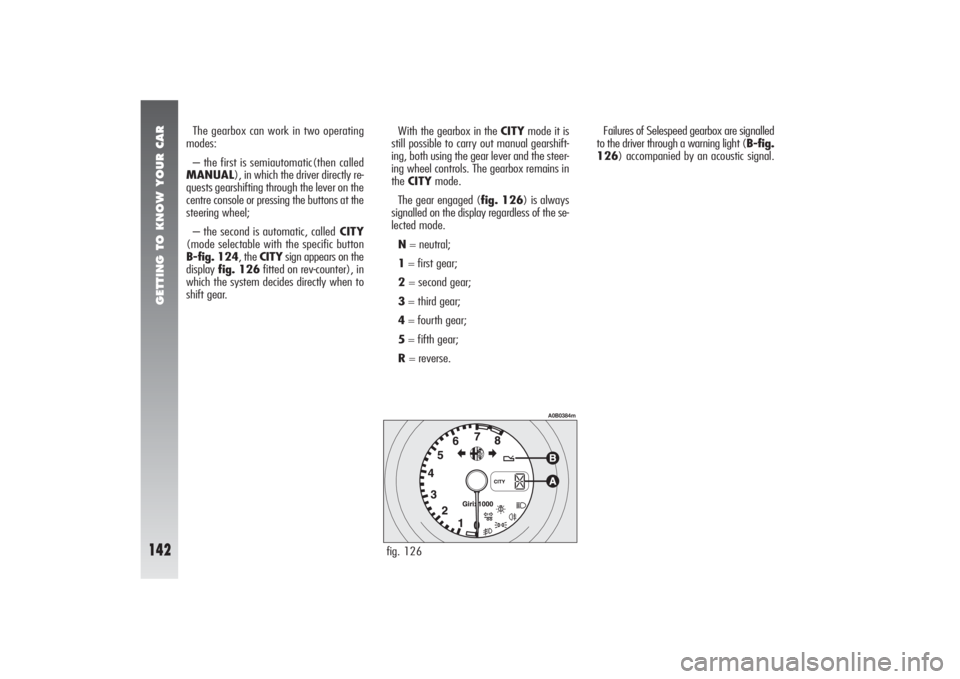
GETTING TO KNOW YOUR CAR
142
Failures of Selespeed gearbox are signalled
to the driver through a warning light (B-fig.
126) accompanied by an acoustic signal. The gearbox can work in two operating
modes:
– the first is semiautomatic(then called
MANUAL), in which the driver directly re-
quests gearshifting through the lever on the
centre console or pressing the buttons at the
steering wheel;
– the second is automatic, calledCITY
(mode selectable with the specific button
B-fig. 124, the CITYsign appears on the
display fig. 126fitted on rev-counter), in
which the system decides directly when to
shift gear.With the gearbox in the CITYmode it is
still possible to carry out manual gearshift-
ing, both using the gear lever and the steer-
ing wheel controls. The gearbox remains in
the CITYmode.
The gear engaged (fig. 126) is always
signalled on the display regardless of the se-
lected mode.
N= neutral;
1= first gear;
2 = second gear;
3= third gear;
4= fourth gear;
5= fifth gear;
R= reverse.
fig. 126
A0B0384m
Page 145 of 357
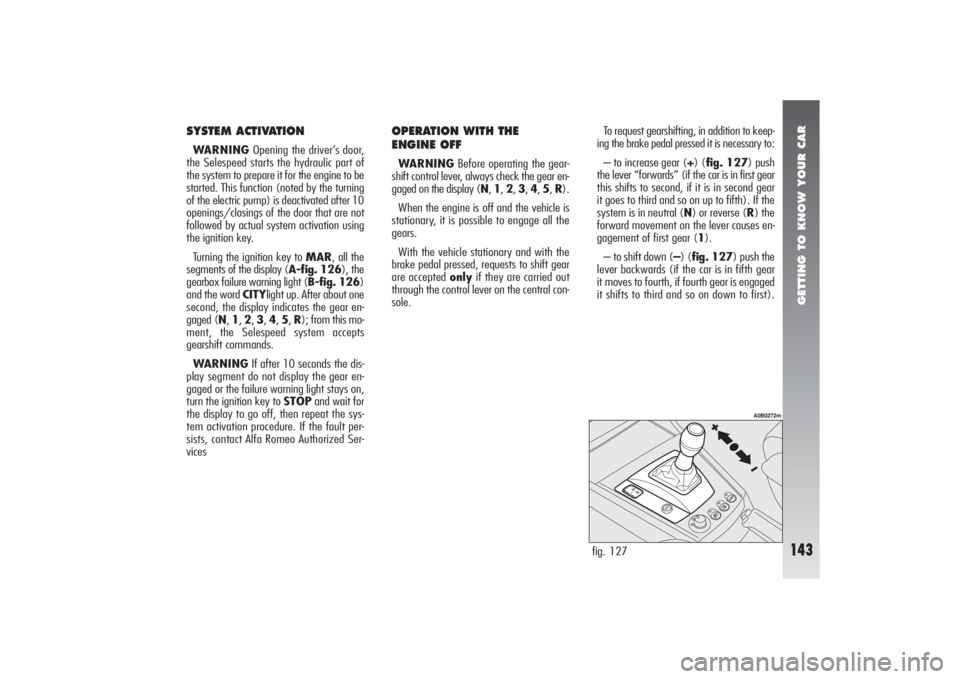
GETTING TO KNOW YOUR CAR
143
SYSTEM ACTIVATIONWARNINGOpening the driver’s door,
the Selespeed starts the hydraulic part of
the system to prepare it for the engine to be
started. This function (noted by the turning
of the electric pump) is deactivated after 10
openings/closings of the door that are not
followed by actual system activation using
the ignition key.
Turning the ignition key to MAR, all the
segments of the display (A-fig. 126), the
gearbox failure warning light (B-fig. 126)
and the word CITYlight up. After about one
second, the display indicates the gear en-
gaged (N, 1, 2, 3, 4, 5, R); from this mo-
ment, the Selespeed system accepts
gearshift commands.
WARNINGIf after 10 seconds the dis-
play segment do not display the gear en-
gaged or the failure warning light stays on,
turn the ignition key to STOPand wait for
the display to go off, then repeat the sys-
tem activation procedure. If the fault per-
sists, contact Alfa Romeo Authorized Ser-
vices
OPERATION WITH THE
ENGINE OFFWARNINGBefore operating the gear-
shift control lever, always check the gear en-
gaged on the display (N, 1, 2, 3, 4, 5, R).
When the engine is off and the vehicle is
stationary, it is possible to engage all the
gears.
With the vehicle stationary and with the
brake pedal pressed, requests to shift gear
are accepted onlyif they are carried out
through the control lever on the central con-
sole.To request gearshifting, in addition to keep-
ing the brake pedal pressed it is necessary to:
– to increase gear (+) (fig. 127) push
the lever “forwards” (if the car is in first gear
this shifts to second, if it is in second gear
it goes to third and so on up to fifth). If the
system is in neutral (N) or reverse (R) the
forward movement on the lever causes en-
gagement of first gear (1).
– to shift down (–) (fig. 127) push the
lever backwards (if the car is in fifth gear
it moves to fourth, if fourth gear is engaged
it shifts to third and so on down to first).
fig. 127
A0B0272m
Page 146 of 357

GETTING TO KNOW YOUR CAR
144
WARNINGOnce a gear has been shifted
it is necessary to release the gearshift con-
trol lever immediately after making the re-
quest. A prolonged action (over 10 seconds)
causes automatic shifting to CITY; previous
conditions are restored when releasing the
lever.
WARNINGIf wanting to leave the car
parked on a sloping road with a gear en-
gaged to keep it braked, it is necessary to
check that the Infocenter display shows the
new gear engaged and then wait for 1 to
2 seconds before releasing the brake pedal
to allow complete clutch engagement.
fig. 129
A0B0274m
To put the gearbox in neutral (N), start-
ing from the condition with the vehicle sta-
tionary and the brake pedal pressed, it is
necessary to move the gearshift control lever
to the right (fig. 128).From any gear (N, 1, 2, 3, 4, 5) and
with the vehicle practically at a standstill,
it is possible to request engagement of re-
verse gear, pushing the lever to the right and
then backwards (fig. 129). If the vehi-
cle is on the move, the request is not ac-
cepted; wait for the car to stop and then
request reverse gear engagement againfig. 128
A0B0273m
Page 147 of 357
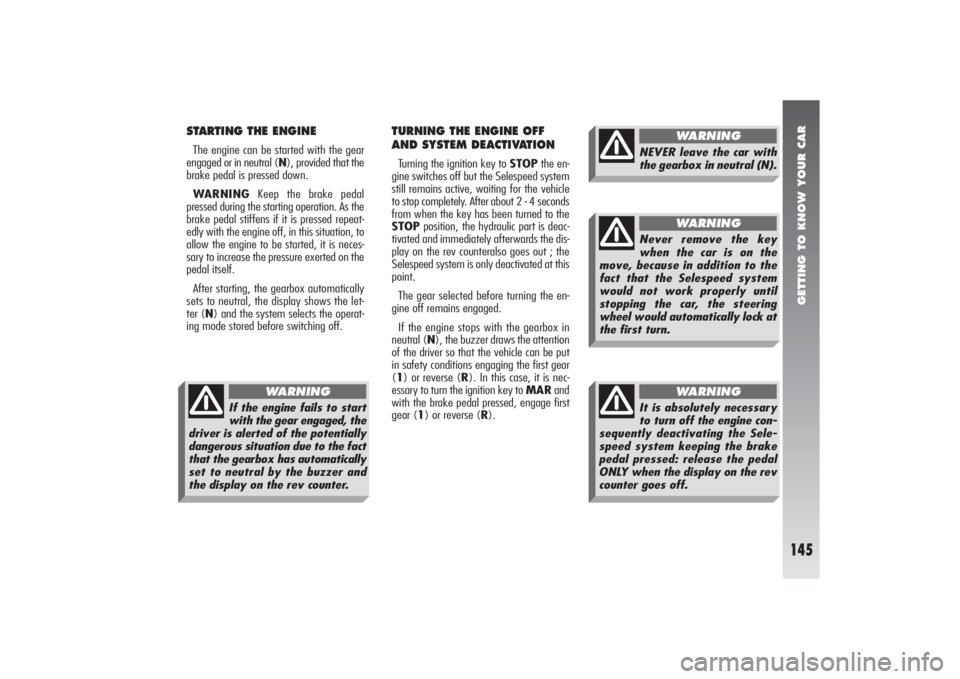
GETTING TO KNOW YOUR CAR
145
STARTING THE ENGINEThe engine can be started with the gear
engaged or in neutral (N), provided that the
brake pedal is pressed down.
WARNINGKeep the brake pedal
pressed during the starting operation. As the
brake pedal stiffens if it is pressed repeat-
edly with the engine off, in this situation, to
allow the engine to be started, it is neces-
sary to increase the pressure exerted on the
pedal itself.
After starting, the gearbox automatically
sets to neutral, the display shows the let-
ter (N) and the system selects the operat-
ing mode stored before switching off.
TURNING THE ENGINE OFF
AND SYSTEM DEACTIVATIONTurning the ignition key to STOPthe en-
gine switches off but the Selespeed system
still remains active, waiting for the vehicle
to stop completely. After about 2 - 4 seconds
from when the key has been turned to the
STOPposition, the hydraulic part is deac-
tivated and immediately afterwards the dis-
play on the rev counteralso goes out ; the
Selespeed system is only deactivated at this
point.
The gear selected before turning the en-
gine off remains engaged.
If the engine stops with the gearbox in
neutral (N), the buzzer draws the attention
of the driver so that the vehicle can be put
in safety conditions engaging the first gear
(1) or reverse (R). In this case, it is nec-
essary to turn the ignition key to MARand
with the brake pedal pressed, engage first
gear (1) or reverse (R).
If the engine fails to start
with the gear engaged, the
driver is alerted of the potentially
dangerous situation due to the fact
that the gearbox has automatically
set to neutral by the buzzer and
the display on the rev counter.
WARNING
NEVER leave the car with
the gearbox in neutral (N).
WARNING
Never remove the key
when the car is on the
move, because in addition to the
fact that the Selespeed system
would not work properly until
stopping the car, the steering
wheel would automatically lock at
the first turn.
WARNING
It is absolutely necessary
to turn off the engine con-
sequently deactivating the Sele-
speed system keeping the brake
pedal pressed: release the pedal
ONLY when the display on the rev
counter goes off.
WARNING
Page 148 of 357
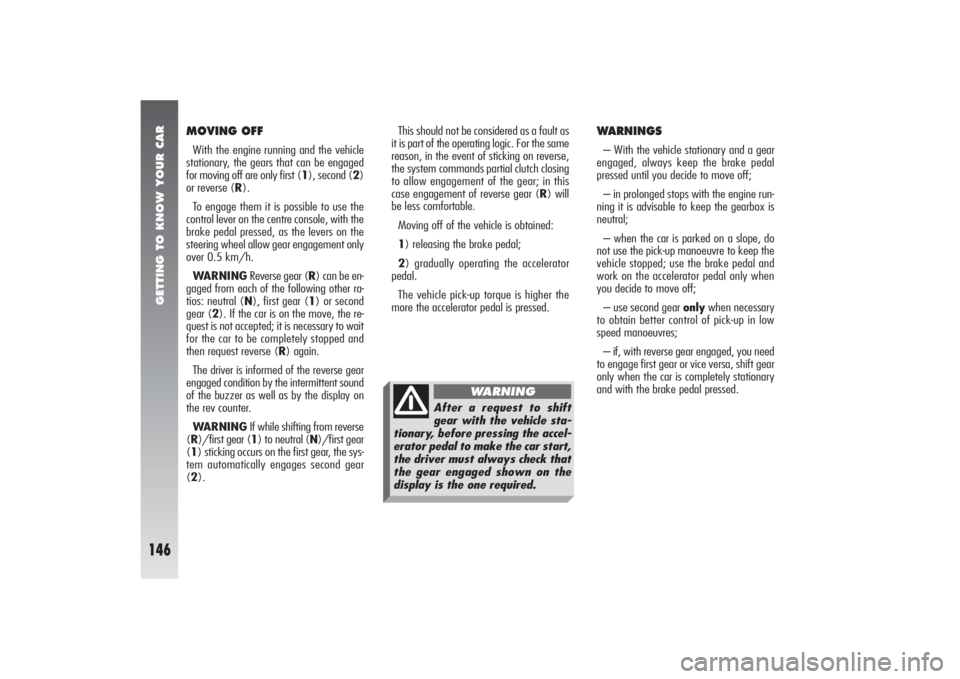
GETTING TO KNOW YOUR CAR
146
WARNINGS– With the vehicle stationary and a gear
engaged, always keep the brake pedal
pressed until you decide to move off;
– in prolonged stops with the engine run-
ning it is advisable to keep the gearbox is
neutral;
– when the car is parked on a slope, do
not use the pick-up manoeuvre to keep the
vehicle stopped; use the brake pedal and
work on the accelerator pedal only when
you decide to move off;
– use second gear onlywhen necessary
to obtain better control of pick-up in low
speed manoeuvres;
– if, with reverse gear engaged, you need
to engage first gear or vice versa, shift gear
only when the car is completely stationary
and with the brake pedal pressed. This should not be considered as a fault as
it is part of the operating logic. For the same
reason, in the event of sticking on reverse,
the system commands partial clutch closing
to allow engagement of the gear; in this
case engagement of reverse gear (R) will
be less comfortable.
Moving off of the vehicle is obtained:
1) releasing the brake pedal;
2) gradually operating the accelerator
pedal.
The vehicle pick-up torque is higher the
more the accelerator pedal is pressed.
MOVING OFFWith the engine running and the vehicle
stationary, the gears that can be engaged
for moving off are only first (1), second (2)
or reverse (R).
To engage them it is possible to use the
control lever on the centre console, with the
brake pedal pressed, as the levers on the
steering wheel allow gear engagement only
over 0.5 km/h.
WARNINGReverse gear (R) can be en-
gaged from each of the following other ra-
tios: neutral (N), first gear (1) or second
gear (2). If the car is on the move, the re-
quest is not accepted; it is necessary to wait
for the car to be completely stopped and
then request reverse (R) again.
The driver is informed of the reverse gear
engaged condition by the intermittent sound
of the buzzer as well as by the display on
the rev counter.
WARNINGIf while shifting from reverse
(R)/first gear (1) to neutral (N)/first gear
(1) sticking occurs on the first gear, the sys-
tem automatically engages second gear
(2).
After a request to shift
gear with the vehicle sta-
tionary, before pressing the accel-
erator pedal to make the car start,
the driver must always check that
the gear engaged shown on the
display is the one required.
WARNING